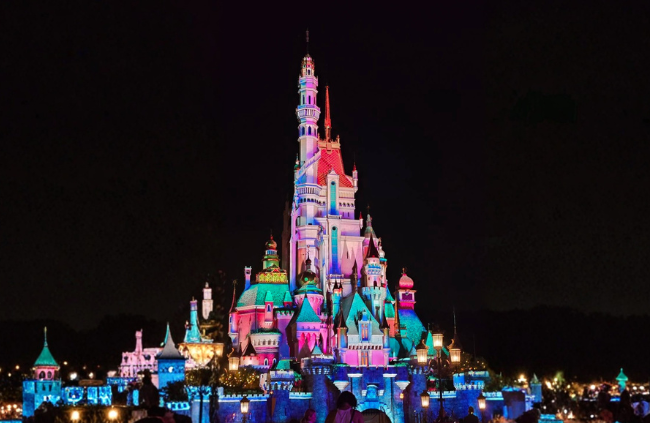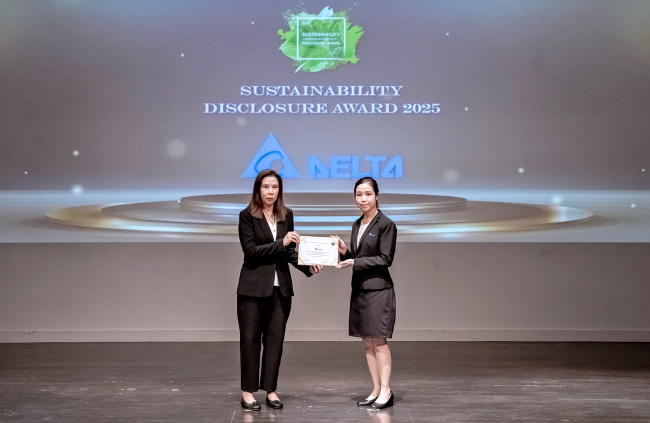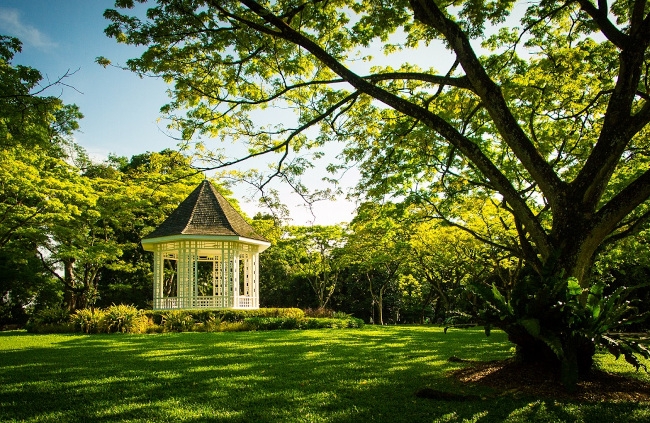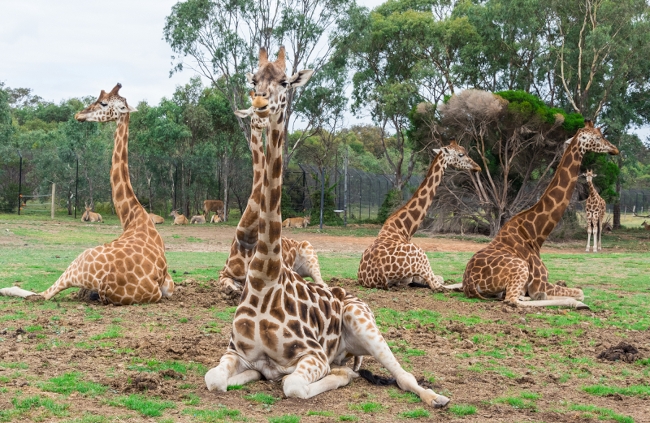Erawan Museum: Microcosm of the Siamese Soul
By Delta Electronics (Thailand) PCL. - Published March 01, 2020
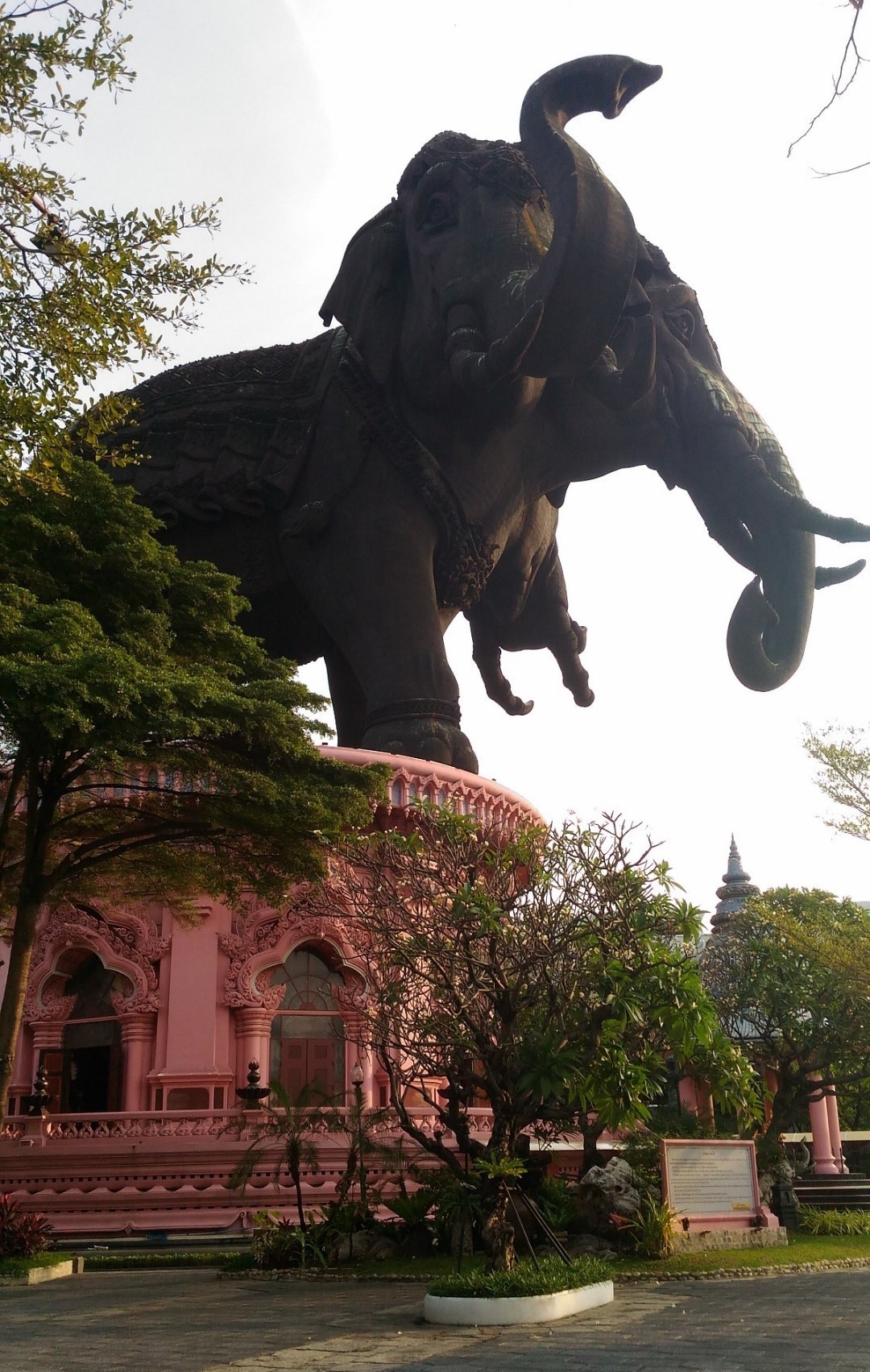 Text and photos by David Nakayama, DET Corp Comms
Text and photos by David Nakayama, DET Corp Comms
Finding the time to enjoy Thailand can be a challenge for visiting colleagues and customers. With so many meetings, surveys and audits crowding our busy schedules, taking in the local sights can become an afterthought. Yet understanding and appreciating local culture is the secret to building a deep rapport with Thais that ultimately lead to lasting business partnerships and friendship. Fortunately, you can get a quick but comprehensive glimpse into the very soul of Siam with a visit to the Erawan Museum.
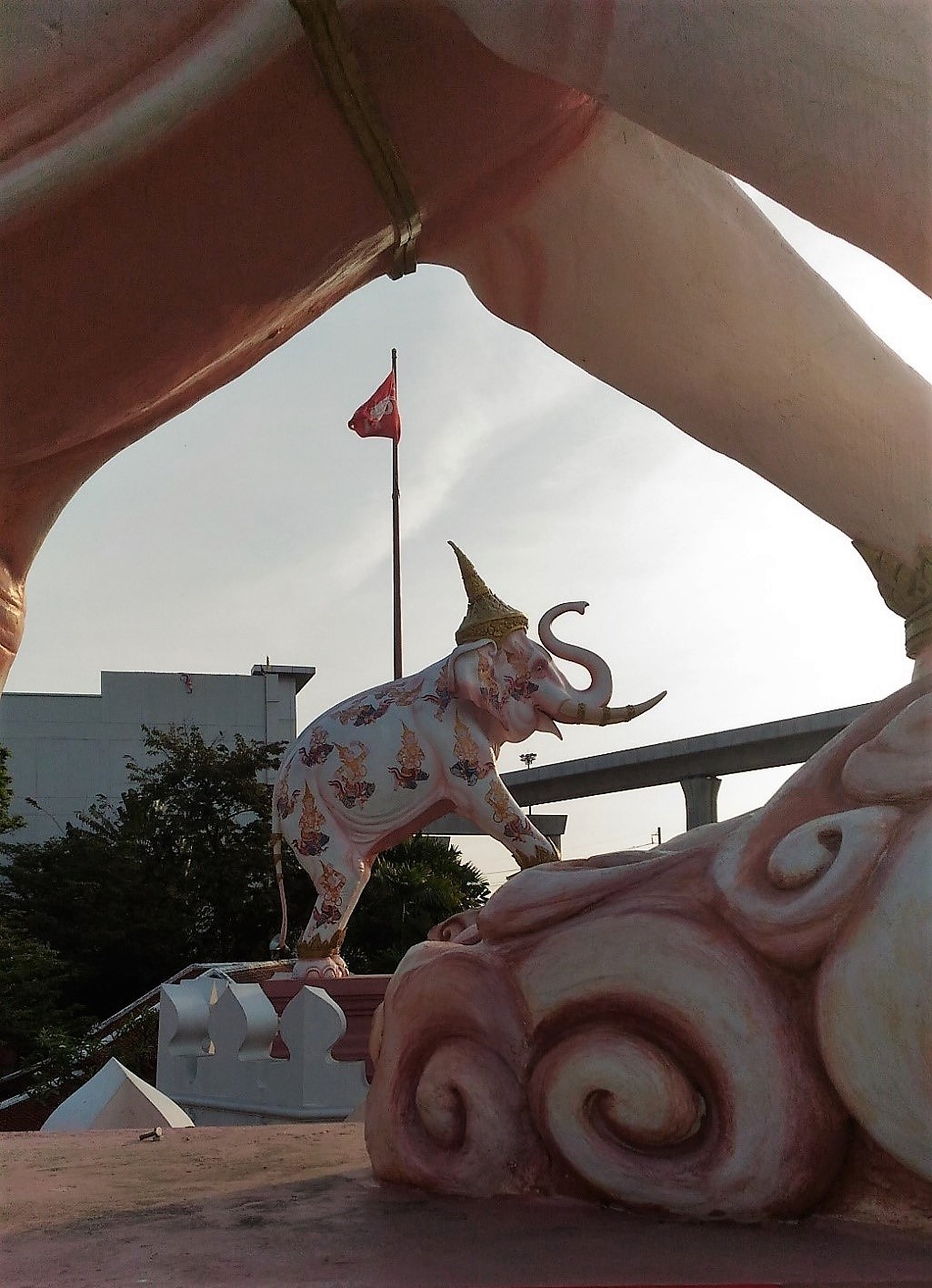 Driving to our Delta Thailand headquarters from Bangkok, you won’t miss the Erawan Museum which is both a landmark and symbol of Samutprakarn Province. The massive black tri-head elephant sits atop a round pink temple and towers over the dusty port of Paknam. Now this startling and surrealistic personification of a Dali painting may come across as a pastiche monstrosity. But if you take an unbiased look inside and you can discover a microcosm of culture, arts, spirituality and philosophy that help you understand what makes Thais tick.
Driving to our Delta Thailand headquarters from Bangkok, you won’t miss the Erawan Museum which is both a landmark and symbol of Samutprakarn Province. The massive black tri-head elephant sits atop a round pink temple and towers over the dusty port of Paknam. Now this startling and surrealistic personification of a Dali painting may come across as a pastiche monstrosity. But if you take an unbiased look inside and you can discover a microcosm of culture, arts, spirituality and philosophy that help you understand what makes Thais tick.
A Spiritual and Cultural Oasis The dusty motorways, car dealerships and packs of stray dogs surrounding the museum are in sharp contrast to the dazzling splendor within its white walls. At the entrance, you pay a 400THB foreigner entrance fee (200THB for Thais or discrete Thai-looking foreigners). You can also take an audio device with a recorded tour, or if you’re foolhardy like me you can stumble blindly through the cultural labyrinth that awaits you. The museum comprises a main building surrounded by smaller Thai and Chinese shrines, gardens and elephant statues galore.
The dusty motorways, car dealerships and packs of stray dogs surrounding the museum are in sharp contrast to the dazzling splendor within its white walls. At the entrance, you pay a 400THB foreigner entrance fee (200THB for Thais or discrete Thai-looking foreigners). You can also take an audio device with a recorded tour, or if you’re foolhardy like me you can stumble blindly through the cultural labyrinth that awaits you. The museum comprises a main building surrounded by smaller Thai and Chinese shrines, gardens and elephant statues galore.
Constructed from 1994 to 2003, Erawan Museum is the legacy and brainchild of eccentric Thai businessman, millionaire and patron of culture Lek Viriyaphan. The name Erawan is the Thai word for the three-headed elephant Airavata that the Hindu god Indra rides. Intended as a gateway to Thailand’s cultural heritage, and a showcase of the late Khun Lek's personal collection of religious objects, the museum is more a quasi-religious mashup of local beliefs, art and craftsmanship that Thais and foreigners can visit for worship or admiration. As a functioning shrine, visitors to the museum should dress as modestly as at any Thai religious site.
The Universe in an Elephant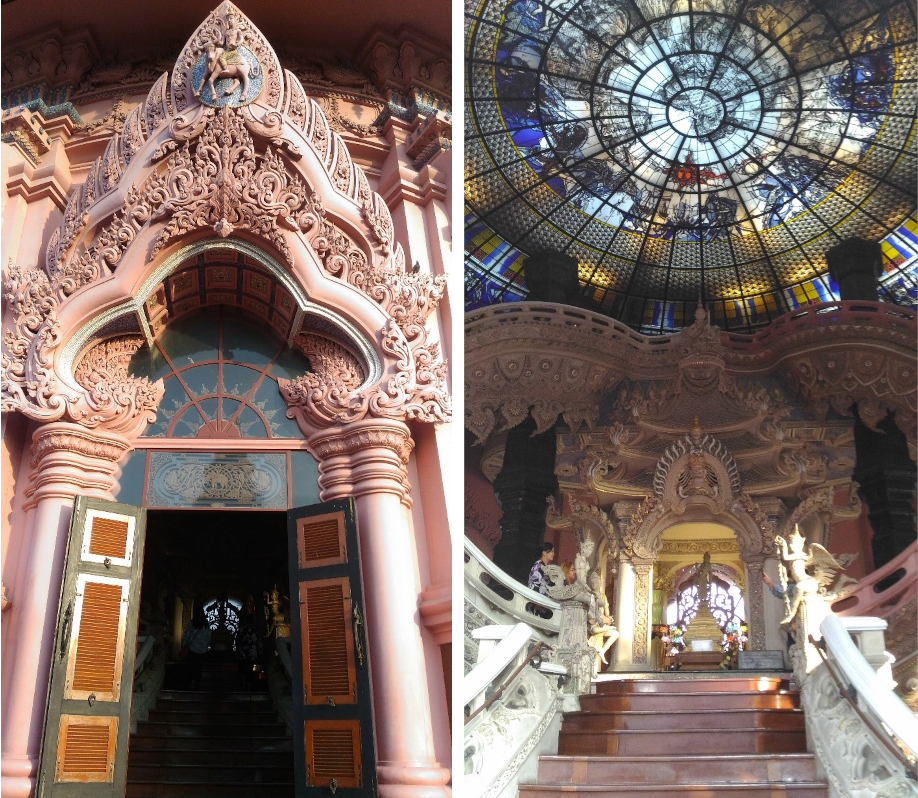 The main building is a Hindu representation of the universe comprising: the Underworld (ground floor), Earth (1st floor) and Heaven (top floor). According to the operator Ancient City Group, the entire structure is 43.6 meters tall (14 stories) and the 12 meter-wide 39 meter-long elephant weighs 150 tons. The elephant sculpture comprises hundreds of thousands of 1.2-millimeter copper sheets.
The main building is a Hindu representation of the universe comprising: the Underworld (ground floor), Earth (1st floor) and Heaven (top floor). According to the operator Ancient City Group, the entire structure is 43.6 meters tall (14 stories) and the 12 meter-wide 39 meter-long elephant weighs 150 tons. The elephant sculpture comprises hundreds of thousands of 1.2-millimeter copper sheets. On the ground floor, you’ll find a mysterious fusion of architectural styles and materials. Thai teak, ceramic tiles, gothic masonry, hand-beaten metal and cathedral-style stained glass windows and ceiling all come together in glorious contrast. The décor is busy with intricate carvings and metalwork depicting Hindu motifs and Siamese patterns covering pillars, eaves, doorways and alcoves. An ivory-white double-winged staircase, featuring a central landing with a shrine, beckons you to ascend from the underworld to the Hindu earth (1st floor). Along the way, statues of otherworldly dancers and minstrels celebrate your ascent to the pachyderm-themed paradise.
On the ground floor, you’ll find a mysterious fusion of architectural styles and materials. Thai teak, ceramic tiles, gothic masonry, hand-beaten metal and cathedral-style stained glass windows and ceiling all come together in glorious contrast. The décor is busy with intricate carvings and metalwork depicting Hindu motifs and Siamese patterns covering pillars, eaves, doorways and alcoves. An ivory-white double-winged staircase, featuring a central landing with a shrine, beckons you to ascend from the underworld to the Hindu earth (1st floor). Along the way, statues of otherworldly dancers and minstrels celebrate your ascent to the pachyderm-themed paradise.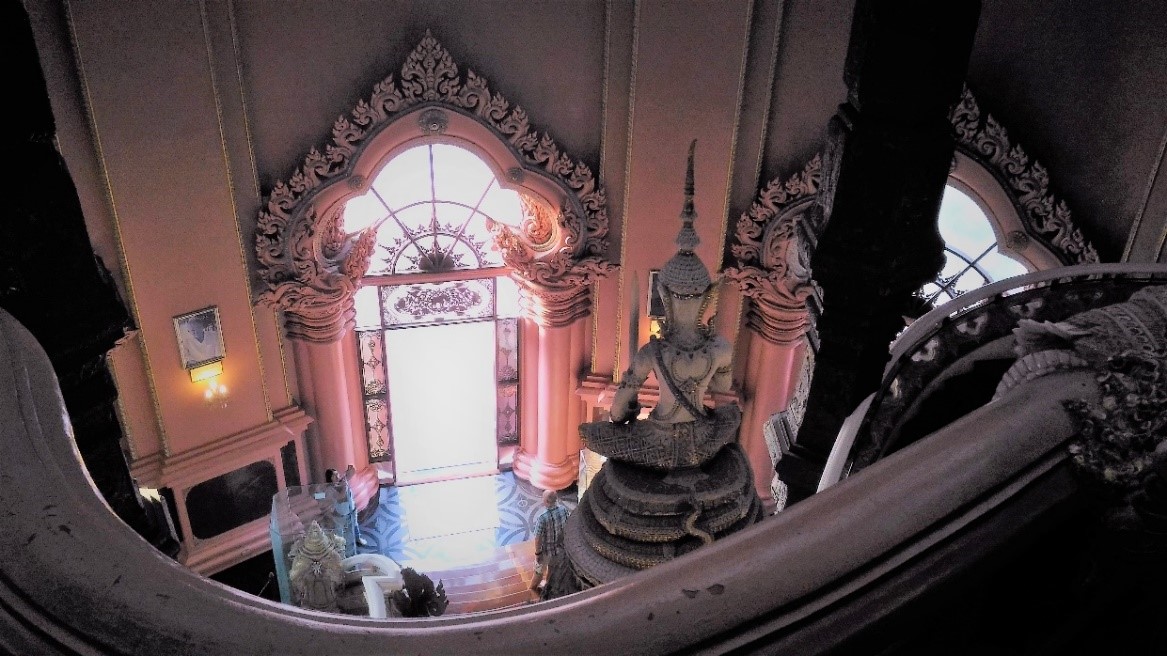 Stairway to Heaven
Stairway to Heaven
On the landing and mezzanine 1st floor you can get panoramic views of the expansive ground floor area, winding staircases and shrine. A white Buddha sits atop the landing area shrine as if ascending on clouds to the Nirvana zone above. The Heaven zone has a plain teak décor and even an elevator for elderly or disabled visitors that gives it a down-to-earth feel. On both sides of this level, you’ll find doors and staircases that lead to up to the upper sanctum inside of the elephant. All along the staircases, you can admire the delicately painted murals of Hindu mythology and Thai folklore. At the top of the staircase, you’ll enter a splendid grotto-like shrine with a pair of Buddha statues (one standing and another seated above) on the far end. On both sides, there are antiquities and religious relics from different eras in Thailand’s long history. This awe-inspiring and esoteric space is part religious sanctuary, art gallery and museum. Religious visitors can meditate or make offerings while all are free to simply appreciate the art, observe the rituals or contemplate the mysteries of the universe in the shadows.
At the top of the staircase, you’ll enter a splendid grotto-like shrine with a pair of Buddha statues (one standing and another seated above) on the far end. On both sides, there are antiquities and religious relics from different eras in Thailand’s long history. This awe-inspiring and esoteric space is part religious sanctuary, art gallery and museum. Religious visitors can meditate or make offerings while all are free to simply appreciate the art, observe the rituals or contemplate the mysteries of the universe in the shadows. Elephants of Erawan
Elephants of Erawan
Besides the main building, the museum compound has a plethora of other depictions and symbols related to Thai beliefs. Visitors can stroll along a circular path around the main building that takes them under the belly and between the front and hind legs of a series of elephant garden statue fountains (water pours from of their outward-facing trunks). Thais believe this action brings fabulous good luck, and every time you pass through a recorded elephant trump will sound to salute your good fortune. White elephants also stand guard on the walls and the ancient white elephant flag of the Siamese kingdom flutters in the breeze.
Elephants are national animals of Thailand and Thais consider white elephants as sacred symbols of royal power that are essential to the wellbeing and prosperity of the Kingdom. All white elephants belong to the king and their number can reflect on the status of king. The museum also has a shrine dedicated to the Hindu elephant-headed god Ganesha alongside a Chinese Confucian patron deity for intellectuals. These shrines all peacefully co-exist with their native compatriots in the diverse Thai religious ecosystem.
Finding Our Way in a Chaotic Cosmos In the end, Erawan Museum can offer takeaways for any open-minded visitor. Whether you’re a casual observer, antiquities scholar, photography enthusiast or pious pilgrim we can all glean our own pearls from the experience. The clashing styles, psychedelic colors and surrealist symbolism may be difficult to wrap your head around, but this may be precisely what makes Erawan Museum a quintessentially Thai monument.
In the end, Erawan Museum can offer takeaways for any open-minded visitor. Whether you’re a casual observer, antiquities scholar, photography enthusiast or pious pilgrim we can all glean our own pearls from the experience. The clashing styles, psychedelic colors and surrealist symbolism may be difficult to wrap your head around, but this may be precisely what makes Erawan Museum a quintessentially Thai monument.
Although I left with more questions than answers, I feel visiting Erawan Museum has made me at least more comfortable with ambiguity. A useful skill indeed, when navigating the sometimes byzantine complexities of work and enjoying an adventurous life in “Amazing Thailand”.
Useful Links:
Location: https://g.page/ErawanMuseumSamutprakan?share
Erawan Museum Official Site: https://www.muangboranmuseum.com/en/landmark/the-erawan-museum/
Additional Information: http://paknam.com/tourist-attractions/the-erawan-museum/



